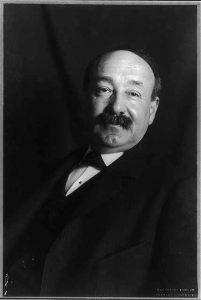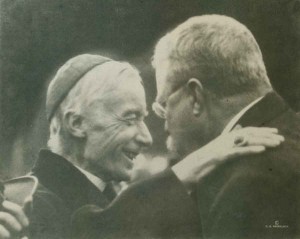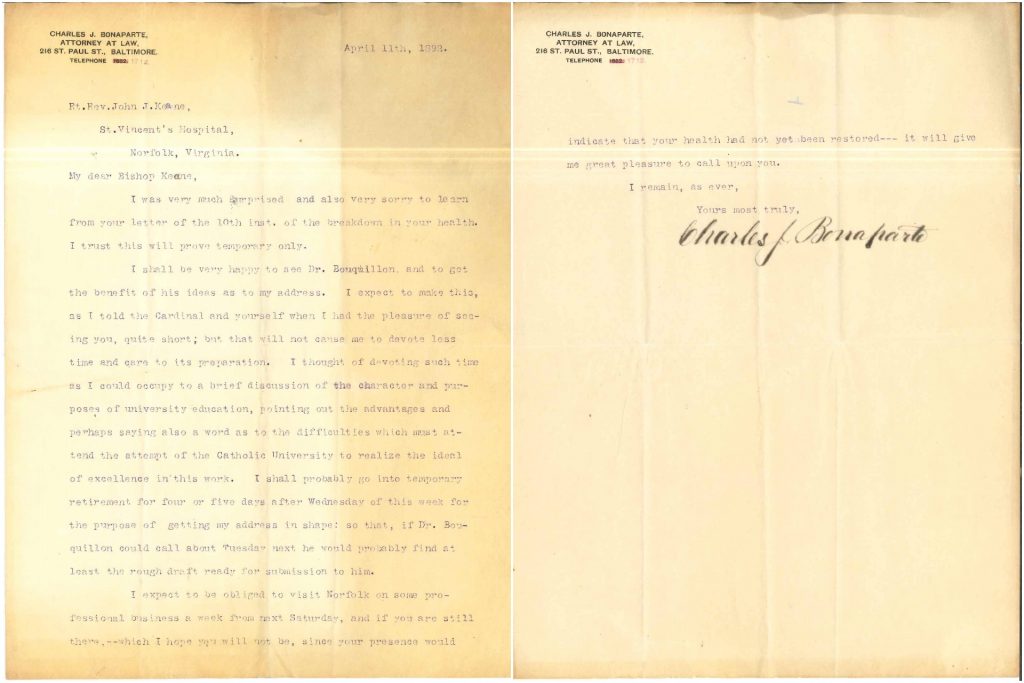Aside from belonging to the branch of American Bonapartes, Charles Joseph Bonaparte (June 9, 1851–June 28, 1921) is perhaps best known for serving as Attorney General in the administration of Theodore Roosevelt. A prominent Baltimorean and a devout Catholic, he was also one of the men responsible for seeing that The Catholic University of America survived its teenage years.

The story of the American Bonapartes begins two generations earlier with a pair of star-crossed lovers: Elizabeth “Betsy” Patterson (1785–1879) and Jérôme Bonaparte (1784–1860), Napoléon’s youngest brother. Legend has it that Betsy escaped from her father’s summer estate in Sykesville, Maryland and rode a mule twenty miles east to Baltimore to attend the ball where she’d heard Jérôme would be. When they danced that night, the two supposedly became entangled… his gold chain in her hair, or her necklace on one of his buttons… accounts vary, but the symbolism stands up. They were married on Christmas Eve in 1803 by none other than John Carroll, the first American archbishop. Significantly, although Napoléon eventually succeeded in breaking them up by imperial decree, preferring that his baby brother make a marriage of convenience to Catharina of Württemberg, the Pope refused to annul Jérôme’s first marriage—a moral victory of perhaps some consolation for the heartbroken Betsy who lived bitterly ever after in Baltimore. Her only son, Jérôme Napoléon “Bo” Bonaparte (1805–1870), would go on to have two sons by a wealthy American woman; Charles was the younger.
A graduate of Harvard Law School, Charles Bonaparte shared Teddy Roosevelt’s interest in civil service reform. He served as Roosevelt’s Secretary of the Navy before being appointed Attorney General in 1906. In that capacity Bonaparte successfully prosecuted the American Tobacco Company (a major victory on the trust-busting front) and established, in 1908, the Bureau of Investigation—which, in 1935, would become the Federal Bureau of Investigation.
Meanwhile, founded in 1887, Catholic University was facing financial ruin by 1904. Detailed accounts of the financial crisis can be found in C. Joseph Neusse’s Centennial History (1990) as well as in the chapter on Charles Bonaparte in Martin J. Moran’s Luminaries (2018), but for now, suffice to say: “The crisis was caused by the University placing its entire endowment in the control of one man [Thomas E. Waggaman], with no oversight” (Moran, p. 169). (Loyal Nook reader and CatholicU alumnus Paul Rybczyk, 1972 and ‘77, recently brought this Washington Post article mentioning Waggaman to our attention!) In January 1904, an “extraordinary meeting” took place at which “Bonaparte of Baltimore” was present; a Finance Committee was formed and Bonaparte was appointed to it; his motion requesting that the “Committee be entrusted with full control over all property […] whether real, personal or mixed” was adopted unanimously. Still the situation took years to straighten out. (For the play-by-play, see the Board of Trustees Meeting Materials, Box 67, especially Folder “Nov. 1904”—which contains correspondence between Waggaman and Bonaparte, albeit by proxy, that was reproduced as exhibits in the relevant legal proceedings.) In the end, Bonaparte recommended that the University accept a settlement which would allow it to recoup 40% of the funds that Waggaman (who had since died) owed. As Moran explains, because Bonaparte was living in D.C. then—serving in T. R.’s administration—he was “available on short notice for consultation during this critical time”; as a result, he “became the principal decision maker right from the start” (Moran, p. 170).

Although in Catholic University history Charles Bonaparte is best remembered for his role in averting the financial crisis, his involvement with the University neither began nor ended with the Finance Committee. Not long after the University first opened in 1889, it planned to add a School of Philosophy, Letters and Sciences; on April 27, 1892, the cornerstone of the new Hall of Philosophy [i.e., McMahon] was laid during a ceremony at which both Bonaparte and his good friend and fellow Baltimorean Cardinal James Gibbons spoke. (According to Moran, Bonaparte actually introduced Cardinal Gibbons to Teddy Roosevelt at his home in 1891; all three were lifelong friends (Moran, p. 171).) As The Church News reported on May 1, 1892, “The lecture hall of the divinity building [Caldwell Hall] was crowded at 4:30 o’clock Wednesday afternoon by invited guests, when the addresses preceding the laying of the corner-stone were delivered.” In his address, Bonaparte called out the mistaken idea that a seminary or university “primarily denot[ed] a building”—a “fairly logical corollary to the view,” he argued, that “education” meant the injection of “book learnin,’” and that “schools of every grade constituted intellectual hypodermic syringes of varying calibres to perform the operation” (Bonaparte, p. 292). “According to this theory,” he added jokingly, “a young man is loaded with information for his life as a camel with water for its desert journey.” Further on, Bonaparte expressed what he believed should be the mission of any education: “to keep ever present to the student’s mind the immensity of his ignorance” (p. 295).

In 1915 Bonaparte was awarded an honorary LL.D. from the University—which celebrated its twenty-fifth anniversary that year, having officially opened in the fall of 1889. (Incidentally, Lawrence Francis Flick was also among the men to receive an honorary degree on that occasion.)
This year marks not only the bicentennial of Napoléon’s death on May 5, 1821, but also the centennial of Charles Bonaparte’s death on June 28, 1921, just weeks after his seventieth birthday—and just months after the death of Cardinal Gibbons on March 24, 1921.
Works Cited
Bonaparte, Charles J. “Address of Charles J. Bonaparte, Esq.” Year Book Vol. 1, 1889–1894, pp. 290–300.
Moran, Martin J. Luminaries of the Catholic University of America. Moranco Publishing, 2018.
Nuesse, C. Joseph. The Catholic University of America: A Centennial History. CUA Press, 1990.
